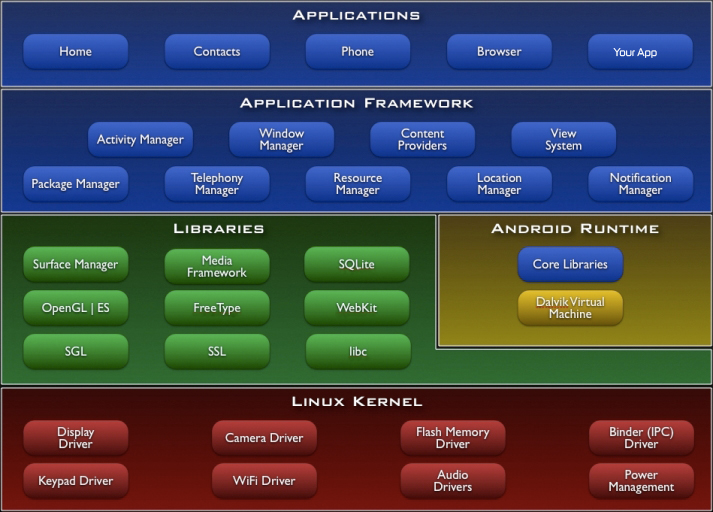先看图:

The above figure shows the diagram of Android Architecture. The Android OS can be referred to as a software stack of different layers, where each layer is a group of sveral program components. Together it includes operating system, middleware and important applications. Each layer in the architecture provides different services to the layer just above it. We will examine the features of each layer in detail.
上面的示意图是Android OS 架构图。Android 操作系统由四层组成,每一层都包括一些程序模块。总体来说包括:操作系统,中间层 和 重要的应用,每一层都把底层实现封装,并暴露调用接口给上一层。
Linux Kernel
The basic layer is the Linux kernel. The whole Android OS is built on top of the Linux 2.6 Kernel with some further architectural changes made by Google. It is this Linux that interacts with the hardware and contains all the essential hardware drivers. Drivers are programs that control and communicate with the hardware. For example, consider the Bluetooth function. All devices has a Bluetooth hardware in it. Therefore the kernel must include a Bluetooth driver to communicate with the Bluetooth hardware. The Linux kernel also acts as an abstraction layer between the hardware and other software layers. Android uses the Linux for all its core functionality such as Memory management, process management, networking, security settings etc. As the Android is built on a most popular and proven foundation, it made the porting of Android to variety of hardware, a relatively painless task
Libraries
The next layer is the Android’s native libraries. It is this layer that enables the device to handle different types of data. These libraries are written in c or c++ language and are specific for a particular hardware.
Some of the important native libraries include the following:
Surface Manager: It is used for compositing window manager with off-screen buffering. Off-screen buffering means you cant directly draw into the screen, but your drawings go to the off-screen buffer. There it is combined with other drawings and form the final screen the user will see. This off screen buffer is the reason behind the transparency of windows.
Media framework: Media framework provides different media codecs allowing the recording and playback of different media formats
SQLite: SQLite is the database engine used in android for data storage purposes
WebKit: It is the browser engine used to display HTML content
OpenGL: Used to render 2D or 3D graphics content to the screen
Android Runtime
Android Runtime consists of Dalvik Virtual machine and Core Java libraries.
Dalvik Virtual Machine
It is a type of JVM used in android devices to run apps and is optimized for low processing power and low memory environments. Unlike the JVM, the Dalvik Virtual Machine doesn’t run .class files, instead it runs .dex files. .dex files are built from .class file at the time of compilation and provides hifger efficiency in low resource environments. The Dalvik VM allows multiple instance of Virtual machine to be created simultaneously providing security, isolation, memory management and threading support. It is developed by Dan Bornstein of Google.
Core Java Libraries
These are different from Java SE and Java ME libraries. However these libraries provides most of the functionalities defined in the Java SE libraries.
Application Framework
These are the blocks that our applications directly interacts with. These programs manage the basic functions of phone like resource management, voice call management etc. As a developer, you just consider these are some basic tools with which we are building our applications.
Important blocks of Application framework are:
Activity Manager: Manages the activity life cycle of applications
Content Providers: Manage the data sharing between applications
Telephony Manager: Manages all voice calls. We use telephony manager if we want to access voice calls in our application.
Location Manager: Location management, using GPS or cell tower
Resource Manager: Manage the various types of resources we use in our Application
Applications
Applications are the top layer in the Android architecture and this is where our applications are gonna fit. Several standard applications comes pre-installed with every device, such as:
- SMS client app
- Dialer
- Web browser
- Contact manager
As a developer we are able to write an app which replace any existing system app. That is, you are not limited in accessing any particular feature. You are practically limitless and can whatever you want to do with the android (as long as the users of your app permits it). Thus Android is opening endless opportunities to the developer.
Linux内核(Linux Kernel)
Android运行在linux kernel 2.6之上,但是把linux内受GNU协议约束的部分做了取代,这样在Android的程序可以用于商业目的。Linux 内核是硬件和软件层之间的抽象层。
中间件
中间件包括两部分:核心库和运行时(libraries & Android runtime)
(1)核心库包括,SurfaceManager 显示系统管理库,负责把2D或3D内容显示到屏幕;Media Framework 媒体库,负责支持图像,支持多种视频和音频的录制和回放;SQlite 数据库,一个功能强大的轻量级嵌入式关系数据库;WebKit 浏览器引擎等。
(2)Dalvik虚拟机:区别于Java虚拟机的是,每一个Android 应用程序都在它自己的进程中运行,都有一个属于自己的Dalvik 虚拟机,这一点可以让系统在运行时可以达到优化,程序间的影响大大降低。Dalvik虚拟机并非运行Java字节码,而是运行自己的字节码。
应用程序框架(Application Framework)
丰富而又可扩展性的视图(Views),可以用来构建应用程序, 它包括列表(lists),网格(grids), 文本框(text boxes),按钮( buttons), 可嵌入的web 浏览器。
内容提供者(Content Providers)使得应用程序可以访问另一个应用程序的数据(如联系人数据库), 或者共享它们自己的数据。
资源管理器(Resource Manager)提供非代码资源的访问,如本地字符串,图形,和布局文件( layoutfiles )。
通知管理器(Notification Manager) 使得应用程序可以在状态栏中显示自定义的提示信息。
活动管理器( Activity Manager) 用来管理应用程序生命周期并提供常用的导航回退功能。
应用程序 (Applications)
Android 系统会内置一些应用程序包包括email 客户端,SMS 短消息程序,日历,地图,浏览器,联系人管理程序等。所有的应用程序都是使用JAVA 语言编写的。
转载来源文献:
http://www.android-app-market.com/android-project-structure.html
http://android.yaohuiji.com/archives/53